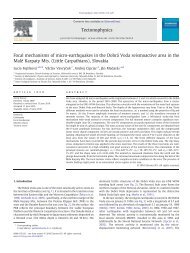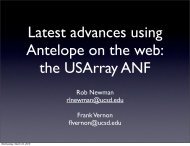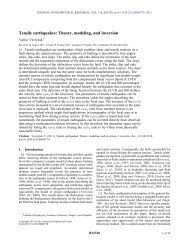Geophysical Institute of the ASCR
Geophysical Institute of the ASCR
Geophysical Institute of the ASCR
Create successful ePaper yourself
Turn your PDF publications into a flip-book with our unique Google optimized e-Paper software.
Acoustic axes in strong and weak triclinic anisotropy<br />
Calculation <strong>of</strong> acoustic axes in triclinic elastic anisotropy is considerably more complicated than for<br />
anisotropy <strong>of</strong> higher symmetry. While one polynomial equation <strong>of</strong> <strong>the</strong> 6th degree is solved in<br />
monoclinic anisotropy, we have to solve two coupled polynomial equations <strong>of</strong> <strong>the</strong> 6th order in two<br />
variables in triclinic anisotropy. Fur<strong>the</strong>rmore, some solutions <strong>of</strong> <strong>the</strong> equations are spurious and must<br />
be discarded. In this way we obtain 16 isolated acoustic axes, which can run in real or complex<br />
directions. The real/complex acoustic axes describe <strong>the</strong> propagation <strong>of</strong> homogeneous/inhomogeneous<br />
plane waves and are associated with a linear/elliptical polarization <strong>of</strong> waves in <strong>the</strong>ir vicinity. The most<br />
frequent number <strong>of</strong> real acoustic axes is 8 for strong triclinic anisotropy and 4 to 6 for weak triclinic<br />
anisotropy. Acoustic axes can exist even under an infinitesimally weak anisotropy, and occur when<br />
slowness surfaces <strong>of</strong> <strong>the</strong> S1 and S2 waves touch or intersect. The maximum number <strong>of</strong> isolated<br />
acoustic axes in weak triclinic anisotropy is 16 as in strong triclinic anisotropy. The directions <strong>of</strong><br />
acoustic axes are calculated by solving two coupled polynomial equations in two variables. The<br />
degree <strong>of</strong> <strong>the</strong> equations is 6 under strong anisotropy and reduces to 5 under weak anisotropy. The<br />
weak anisotropy approximation is particularly useful, when calculating <strong>the</strong> acoustic axes under<br />
extremely weak anisotropy with anisotropy strength less than 0.1%, because <strong>the</strong> equations valid for<br />
strong anisotropy might become numerically unstable and <strong>the</strong>ir modification, which stabilizes <strong>the</strong>m,<br />
is complicated. The weak anisotropy approximation can also find applications in inversions for<br />
anisotropy from <strong>the</strong> directions <strong>of</strong> acoustic axes.<br />
References<br />
Vavryčuk, V., 2005a. Acoustic axes in triclinic anisotropy. J. Acoust. Soc. Am., 118, 647-653.<br />
Vavryčuk, V., 2005b. Acoustic axes in weak triclinic anisotropy, Geophys. J. Int., 163, 629-638, doi: 10.1111/j.1365-<br />
246X.2005.02762.x.<br />
First-order ray tracing for smooth inhomogeneous weakly<br />
anisotropic media<br />
Ray tracing procedures represent basis <strong>of</strong> many seismic processing techniques as, e.g., prestack<br />
Kirchh<strong>of</strong>f depth migration or AVO. Since majority <strong>of</strong> rocks are <strong>of</strong>ten anisotropic, and specifically<br />
weakly anisotropic, development <strong>of</strong> ray tracing procedures for such kinds <strong>of</strong> media is desirable. Using<br />
<strong>the</strong> perturbation <strong>the</strong>ory, in which deviations <strong>of</strong> anisotropy from isotropy are considered to be <strong>the</strong> firstorder<br />
quantities, we derived first-order ray-tracing equations for P waves, see Pšenčík and Farra<br />
(2005). The traveltimes calculated along <strong>the</strong>se rays are also <strong>of</strong> <strong>the</strong> first order. In order to increase <strong>the</strong><br />
accuracy <strong>of</strong> <strong>the</strong> traveltimes, a simple second-order correction calculated along rays can be used. All<br />
equations are expressed in terms <strong>of</strong> weak anisotropy parameters, which represent a more natural<br />
parameterization <strong>of</strong> weakly anisotropic media than standard elastic parameters. Only 15 weak<br />
anisotropy parameters describing P-wave propagation are involved.<br />
Results <strong>of</strong> numerical tests in medium whose horizontal axis <strong>of</strong> symmetry rotates with increasing<br />
depth, called HTI-ROT are shown in Fig. 28. A VSP experiment is considered, in which <strong>the</strong> source<br />
and <strong>the</strong> borehole are situated in a vertical plane. The borehole is vertical, <strong>the</strong> source is located on <strong>the</strong><br />
surface, in <strong>the</strong> distance <strong>of</strong> 1 km from <strong>the</strong> borehole. Results obtained with exact ray tracing and FORT<br />
coincide so well that no differences are visible. The differences are made visible in Fig. 29, where <strong>the</strong><br />
relative travel time differences (from exact travel times) corresponding to <strong>the</strong> first- (black) and<br />
second-order (red) traveltimes are plotted.<br />
43














